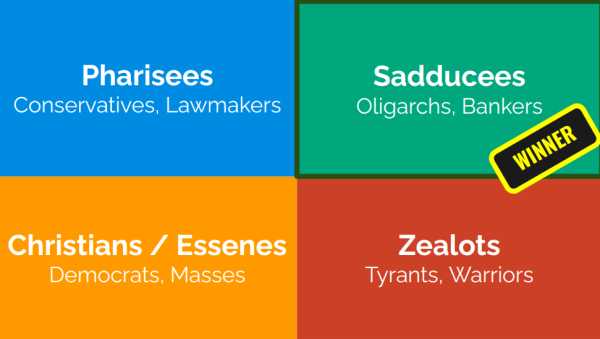The Crucifixion of Jesus According to Social Cycles
April 3, 2023 3 minutes • 527 words
Table of contents
Historical facts will reveal that the crucifixion of Jesus had little to do with spirituality, but everything to do with politics.
Jesus lived in a time when Israel had just transitioned from Greek influence and moved under Roman tyranny. This transition caused a civil war between 2 major factions: the Sadducees and the Pharisees.

The Sadducees were the oligarchs (vaesyas) and neoliberals of that period. Proof is that they built and managed temples. In the Roman times, temples also served as banks. This is why Jesus encountered many moneychangers in the Temple and tried to drive them out (Mark 11:15-17).
The Pharisees were the religious conservatives (brahmins), lawmakers, and politicians, simlar to modern Republicans and Tory.
The Zealots were the militants (ksatriyas) who wanted to overthrow Roman rule through a ‘Messiah’ which was a warrior-king like David.
The Christians and Esseness were democrats (shudras) who advocated freedom. Notice how Jesus promoted forgiveness and overturned the Pharisees’ eye-for-an-eye policy (Matthew 5:38-39) and the militant ways of the Zealots (Matthew 26:52).
Morever, Jesus preferred tactic for getting followers was by giving free food (Matthew 14:13-21) and healthcare (Luke 4:40).
The Romans defeated all these factions in 70 AD. They destroyed the Temple, carrying the Sadducees gold into Rome. Out of the ashes of the collapse of the Jews arose a class of modern Sadducees as moneylenders and bankers which are dominant even today. Of all the factions, the tradition of the Sadducees survived.
In the end, the Prophet Mohammad fixed the fragmented Jewish political system by creating a new religious law (the Quran) that had policies for the economy, military, and civil rights.
A Better Strategy
Instead of giving free food (multiplying bread) and healthcare (healing the sick), a better policy solution would have been for Jesus to ally with the Sadduccees to aid in tax collection under a liberalized version of tax farming.
In this case, the apostle Matthew (a tax collector) would be the leader instead of Peter (a fisherman).
The Christians would then encourage investment, trade, and moneychanging in order to raise sales tax revenues so that the oppressive Roman poll tax (tributum capitis) could be reduced.
With less oppression, there would be no Jewish Revolt in 66 AD which led to the destruction of Jerusalem in 70 AD, since that revolt was caused primarily by high taxation.
To be fair, the Pharisees did ask Jesus about his taxation policy (Matthew 22:15-21). Jesus replied that only direct revenues from Roman capital could be remitted back to Rome (give back to Caesar what is Caesar’s).
But the whole problem was that Roman investment was very low since there were many civil wars in that area. This is the very reason for low capital formation and subsequent low tax revenues unable to pay Roman administrative expenses.
A liberalized tax farming system would therefore get small revenue at high volume from informal and small capitals that the Romans had no time to micromanage.
The Prophet Mohammad’s solution is a lower poll tax (jizya) which was augmented by a 10% sales tax and a ban on interest on loans. This superior system helped Islam spread and produced far less revolts.






